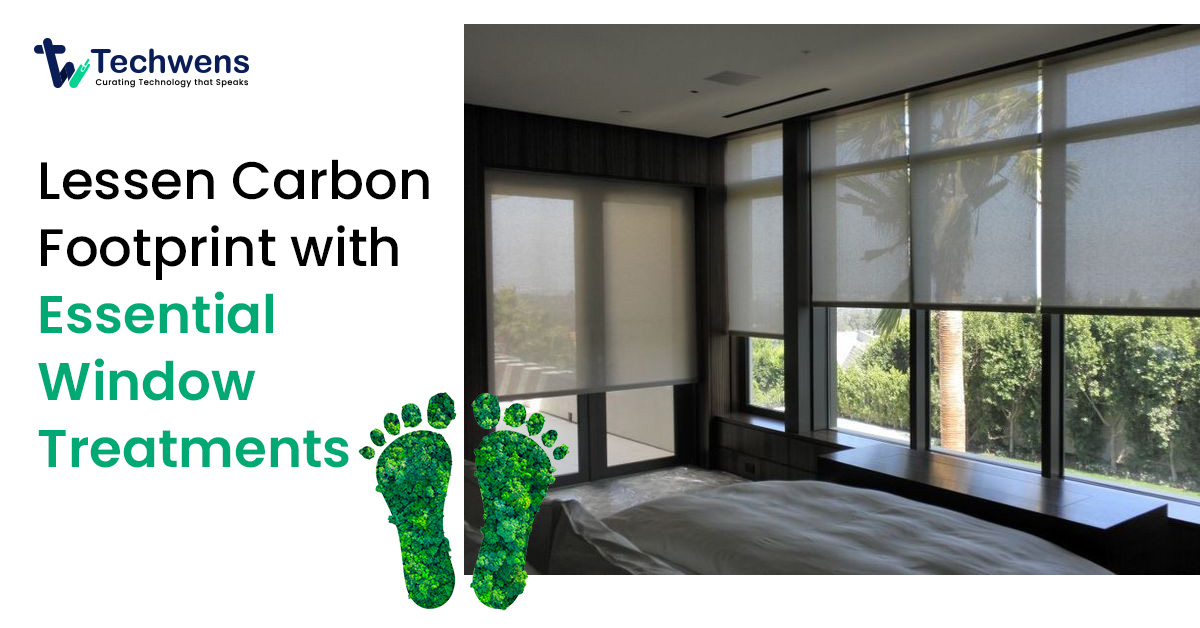Pricilla Gomes
February 3, 2023

Want to make a difference but need to know where to start? Well, look no further than your windows! That’s right, your windows can be a simple and effective way to reduce your carbon footprint.
By choosing the right window treatments, you can save energy, use sustainable materials, and even create your window treatments to reduce waste.
So, let’s take a closer look at how you can positively impact the environment while sprucing up your space with some eco-friendly window treatments.
Get ready to go green with your windows!
Table of Contents

Why Using Energy-Efficient Window Treatments Highly Beneficial?
Gone are the days when window treatments were only meant for privacy and light control. With the rising cost of energy, it’s time to upgrade your window game with energy-efficient window treatments that provide insulation, reduce heat gain/loss, and block harmful UV rays.
Let’s talk about some of these super-efficient window treatments that will make your home cozy and energy-efficient reducing carbon footprint:
Cellular Shades
These honeycomb-shaped shades trap air in their cells, forming a barrier against heat and cold, making them a perfect insulator. Their unique design also diffuses light, reducing glare and increasing privacy.
Roller Shades
These shades are a classic option for any home, and they also come in energy-efficient options. They can be customized to fit any window size and shape, and their tight-fitting design helps reduce heat transfer.
Roman Shades
Roman shades are elegant and sophisticated, and they also have an energy-efficient option. Their fabric is lined with thermal material, which helps insulate your home, keeping it warm in the winter and cool in the summer.
Insulated Curtains
These heavy-duty curtains are lined with insulating material that helps regulate the temperature in your home. They are perfect for bedrooms, living rooms, and any other area where you want to create a cozy and comfortable environment.
The Environmental Impact of Traditional Window Treatments
Traditional window treatments are like energy vampires that suck the life out of the environment. They are not only harmful to the planet but also to your wallet.
Let’s delve into the environmental impact of traditional window treatments and why it’s time to say goodbye to them:
- Blinds: The majority of blinds are made from PVC, which is a petroleum-based plastic. The production of PVC requires a significant amount of energy, and it emits toxic chemicals that pollute the environment. Moreover, once these blinds reach the end of their lifespan, they are non-biodegradable, which means they will remain in landfills for hundreds of years.
- Curtains: Most curtains are made from synthetic materials like polyester, which are produced from non-renewable resources like crude oil. The manufacturing process of these materials involves the emission of greenhouse gases, which contribute to climate change. Additionally, curtains can trap heat, which can increase energy consumption, especially during the summer months.
- Shutters: While shutters may seem like a more eco-friendly option, the reality is that they are not. Most shutters are made from wood, which contributes to deforestation. The production of wood products also requires a lot of energy, and the chemicals used in the process can be harmful to the environment.
- Drapes: Like curtains, most drapes are made from synthetic materials that are not biodegradable. The production process of these materials also generates a lot of waste and pollution, contributing to environmental degradation.
Sustainable Window Treatments to Reduce Carbon Footprint
Bamboo Shades
These shades are not only durable but also renewable and biodegradable. Bamboo grows rapidly, making it an excellent choice for sustainable window treatments. Its natural beauty and texture make it a favorite among interior designers.
Linen Curtains
Linen is a biodegradable natural fiber, making it a sustainable choice for window treatments. It is also durable and can withstand the test of time, so you won’t have to replace it as often. Linen curtains come in a variety of colors and patterns, making them a versatile choice for any room.
Organic Cotton Curtains
Organic cotton is grown without harmful chemicals and pesticides, making it an eco-friendly option for window treatments. It is also soft and breathable, making it an excellent choice for bedrooms and living rooms.
Polyester Curtains
These curtains are made from recycled plastic bottles, making them an excellent choice for environmentally conscious homeowners. Recycled polyester curtains come in a variety of colors and patterns, making them a stylish choice for any room.
The Connection Between Blinds & Shades and Carbon Footprint
Blinds and shades play a significant role in reducing carbon footprint in homes and buildings. By choosing the right type of window treatment, you can minimize your energy usage and carbon footprint.
For example, installing energy-efficient cellular shades or insulated drapes can help keep your home cool during the summer and warm during the winter, reducing your reliance on heating and cooling systems.
This, in turn, lowers your energy consumption and reduces your carbon footprint.
In addition, the materials used in blinds and shades can also impact carbon footprint. Traditional materials such as plastic, vinyl, and polyester are not biodegradable and can harm the environment.
By choosing window treatments made from sustainable materials like bamboo, organic cotton, or linen, you can reduce your carbon footprint while still achieving a stylish look.
Furthermore, the maintenance and disposal of blinds and shades also affect the carbon footprint. Properly maintaining your window treatments can extend their lifespan, reducing the need for replacements and waste.
And when it’s time to dispose of old window treatments, donating or recycling them can prevent them from ending up in landfills and contribute to a more sustainable future.
Overall, choosing the right type of blinds and shades can make a significant difference in reducing carbon footprint and preserving the planet.